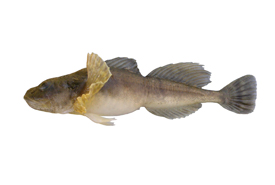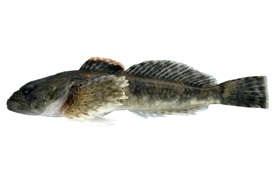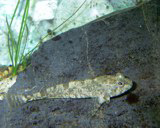Something’s Fishy: Swimming with the sculpin

Deepwater sculpin (Photo by Doug Watkinson/Fisheries and Oceans Canada)
The first time I saw a sculpin splashing around was in a large bucket, among several other fish species, captured for a population survey of small creek on a piece of residential land. I was working with the Central Lake of Ontario Conservation Authority (CLOCA) in Oshawa, Ontario as an aquatics monitoring assistant. It was unlike anything I had ever seen before.
It was a fish smaller than my hand with giant cheeks and a flat head. I spent most of that summer afternoon referring to my field guide, studying every fin and gill of its scaleless body. I identified the sculpin as a mottled sculpin (Cottus bairdii), a species native to lakes across North America.
The sculpin (Cottoidei) is a fish group comprising more than 300 species found in waterbodies throughout the world, 63 species in Canada. They can be identified by their broad flattened head, scaleless bodies, and spiny dorsal and lateral fins. Sculpins are on average five to 20 centimetres long but some species may reach up to 100 centimetres. Sculpins are considered bottom-dwellers and often hunt in and occupy the benthic zone of lakes and oceans, or the substrate of cool streams. Due to their location, they lack swim bladders usually in fish as a floatation device for swimming.

Rocky Mountain sculpin (Cottus bairdii) (Photo by Doug Watkinson/Fisheries and Oceans Canada)
Several sculpin species are considered threatened and at risk in Canada. The Rocky Mountain sculpin can only be found in the Milk and St. Mary River watersheds of Alberta as well as in the Flathead River in British Columbia. The Cultus pygmy sculpin is one of the smallest sculpin species in the world, reaching to only 50 millimetres in its adulthood. It is in danger due to their very limited distribution, only inhabiting the Cultus Lake in southwestern British Colombia. The deepwater sculpin distribution is almost entirely limited to Canada, with the exception of the American regions of the Great Lakes. Their diet consists of zooplankton and sometimes may prey on leeches, fish eggs and sphaeriid clams. As their name suggests, the deepwater sculpin is a bottom-dwelling fish found in cold (minus seven degrees Celsius), well-oxygenated waters.

Cultus pygmy sculpin (Cultus population) (Photo by Sylvia Letay)
Although these species are out of CLOCA’s distribution, I encountered several sculpin species that furthered my appreciation for these small, benthic-level chillers. Although larger species such as large-mouth bass or Northern pike are often great indicators for the health of an ecosystem, they can overshadow the little guys.
I gained an understanding of how they are contributing to growing and changing habitats. For example, the deepwater sculpin are the primary prey for the lake trout, a once predominate fish species in the Great Lakes before overfishing and the introduction of invasive sea lampreys depleted the population. Since then, there has also been a significant decline in deepwater sculpin (between 1942 and 2002 only six were captured) due to the introduction of the rainbow smelt and alewife. Larger species such as lake trout depend on sculpins as a food source in order to survive. In turn sculpins eat smaller inhabitants which help control the population of creatures such as zooplankton.
At Nature Conservancy of Canada (NCC), preservation extend past land. Every day conservation efforts are incorporated on our properties to ensure water and the creatures who call it home are being looked after. To keep these water bodies happy it is critical to keep these sculpins swimming.
Something’s Fishy is a monthly series written by NCC’s Communications Assistant, Raechel Bonomo, highlighting a species or group of fishes that inhabitant Canadian waters.
Learn more:
Aquatic Species at Risk - Rocky Mountain Sculpin (Eastslope populations)
Aquatic Species at Risk - Deepwater Sculpin (Great Lakes - Western St. Lawrence populations)
Aquatic Species at Risk - Coastrange Sculpin (Cultus population)


